Report: Analyzing the Organizational Strategy of Samsung Electronics
VerifiedAdded on 2021/06/17
|17
|4834
|210
Report
AI Summary
This report provides an in-depth analysis of Samsung Electronics' organizational strategy, focusing on its application of Porter's generic strategies, specifically cost leadership and differentiation. The report examines how Samsung has leveraged these strategies to gain a competitive advantage in the technology market, particularly in the mobile phone sector. It discusses the impact of these strategies on Samsung's organizational culture and structure, highlighting the company's focus on innovation, quality, and cost efficiency. The analysis also considers the evolution of Samsung's strategies, its ability to adapt to market changes, and its success in surpassing competitors like Nokia and Sony, with a focus on the role of economies of scale, scope, and a strong corporate culture. The report concludes by emphasizing the importance of maintaining a strong differentiation strategy in a highly competitive and dynamic market, and how the company's strategic choices have influenced its financial performance and revenue streams. This report is contributed by a student to be published on Desklib.
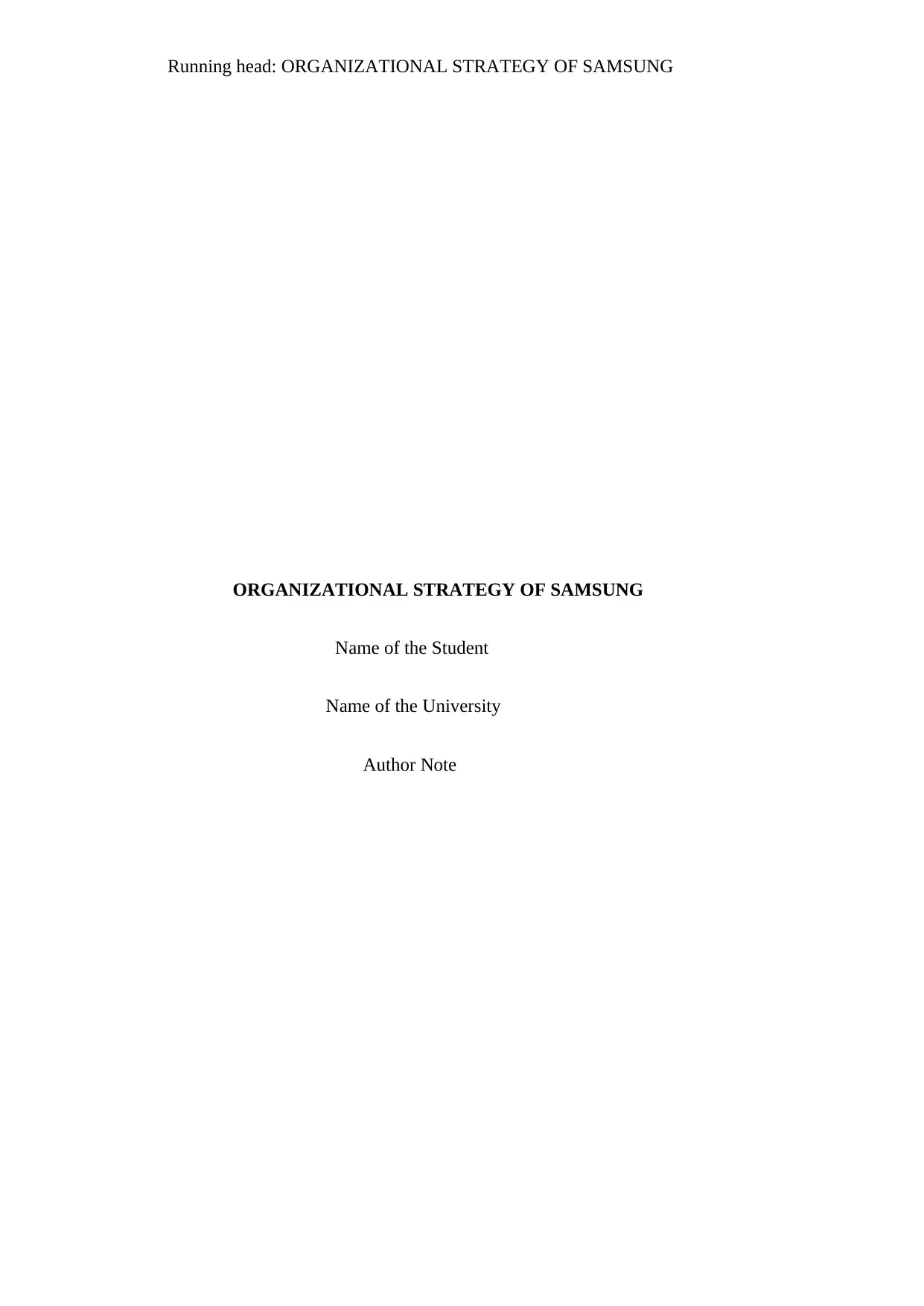
Running head: ORGANIZATIONAL STRATEGY OF SAMSUNG
ORGANIZATIONAL STRATEGY OF SAMSUNG
Name of the Student
Name of the University
Author Note
ORGANIZATIONAL STRATEGY OF SAMSUNG
Name of the Student
Name of the University
Author Note
Paraphrase This Document
Need a fresh take? Get an instant paraphrase of this document with our AI Paraphraser
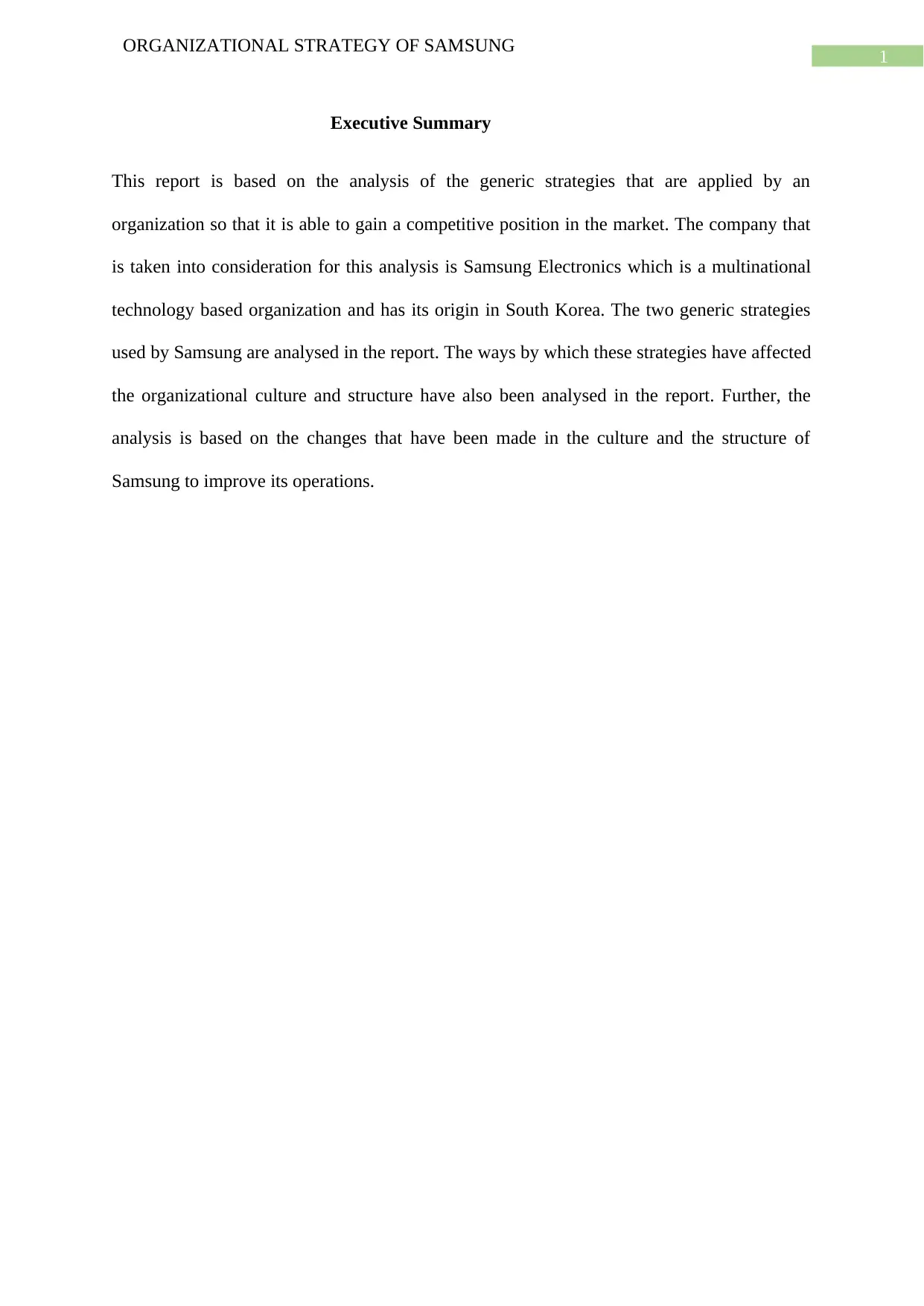
1
ORGANIZATIONAL STRATEGY OF SAMSUNG
Executive Summary
This report is based on the analysis of the generic strategies that are applied by an
organization so that it is able to gain a competitive position in the market. The company that
is taken into consideration for this analysis is Samsung Electronics which is a multinational
technology based organization and has its origin in South Korea. The two generic strategies
used by Samsung are analysed in the report. The ways by which these strategies have affected
the organizational culture and structure have also been analysed in the report. Further, the
analysis is based on the changes that have been made in the culture and the structure of
Samsung to improve its operations.
ORGANIZATIONAL STRATEGY OF SAMSUNG
Executive Summary
This report is based on the analysis of the generic strategies that are applied by an
organization so that it is able to gain a competitive position in the market. The company that
is taken into consideration for this analysis is Samsung Electronics which is a multinational
technology based organization and has its origin in South Korea. The two generic strategies
used by Samsung are analysed in the report. The ways by which these strategies have affected
the organizational culture and structure have also been analysed in the report. Further, the
analysis is based on the changes that have been made in the culture and the structure of
Samsung to improve its operations.
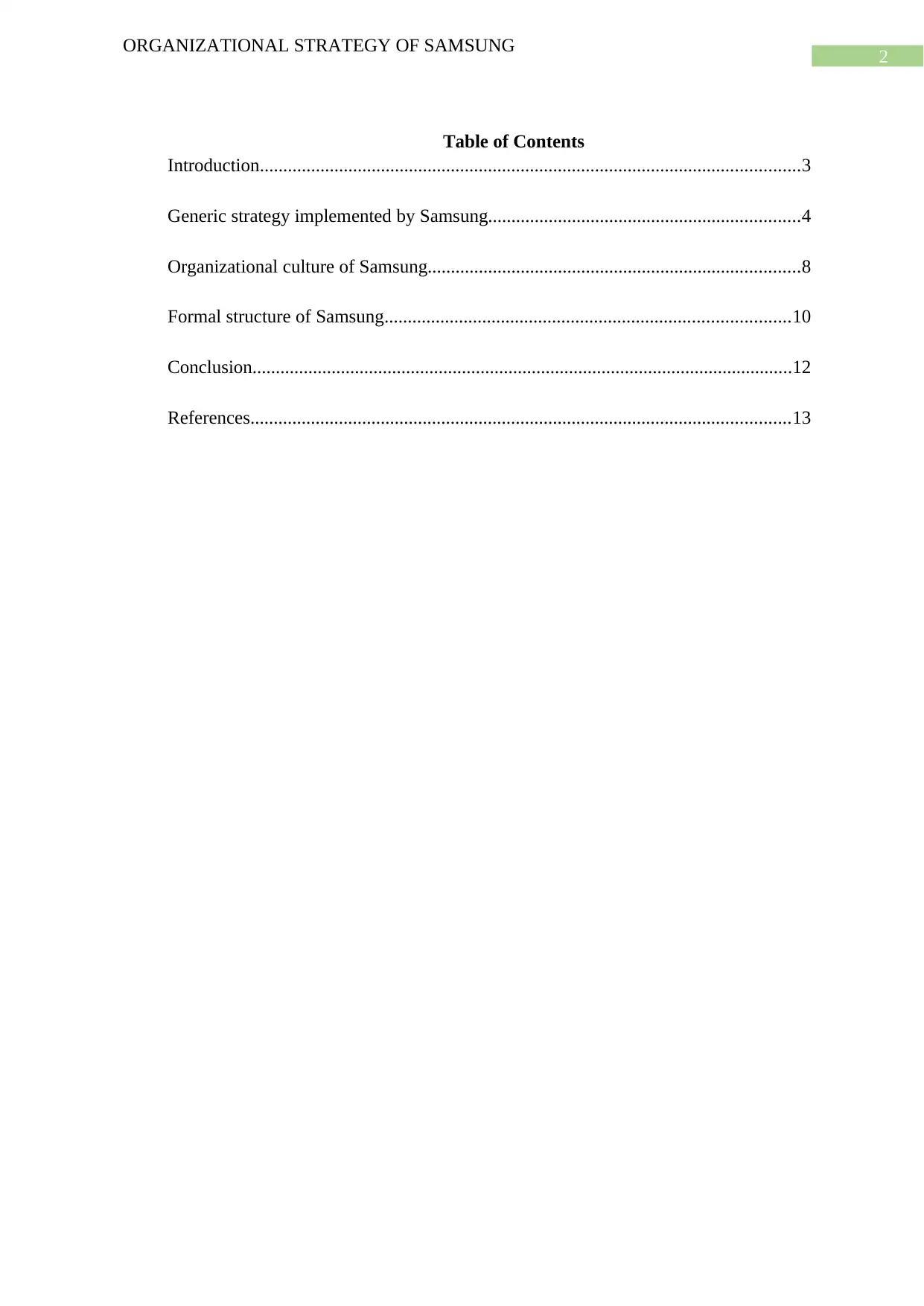
2
ORGANIZATIONAL STRATEGY OF SAMSUNG
Table of Contents
Introduction....................................................................................................................3
Generic strategy implemented by Samsung...................................................................4
Organizational culture of Samsung................................................................................8
Formal structure of Samsung.......................................................................................10
Conclusion....................................................................................................................12
References....................................................................................................................13
ORGANIZATIONAL STRATEGY OF SAMSUNG
Table of Contents
Introduction....................................................................................................................3
Generic strategy implemented by Samsung...................................................................4
Organizational culture of Samsung................................................................................8
Formal structure of Samsung.......................................................................................10
Conclusion....................................................................................................................12
References....................................................................................................................13
⊘ This is a preview!⊘
Do you want full access?
Subscribe today to unlock all pages.

Trusted by 1+ million students worldwide
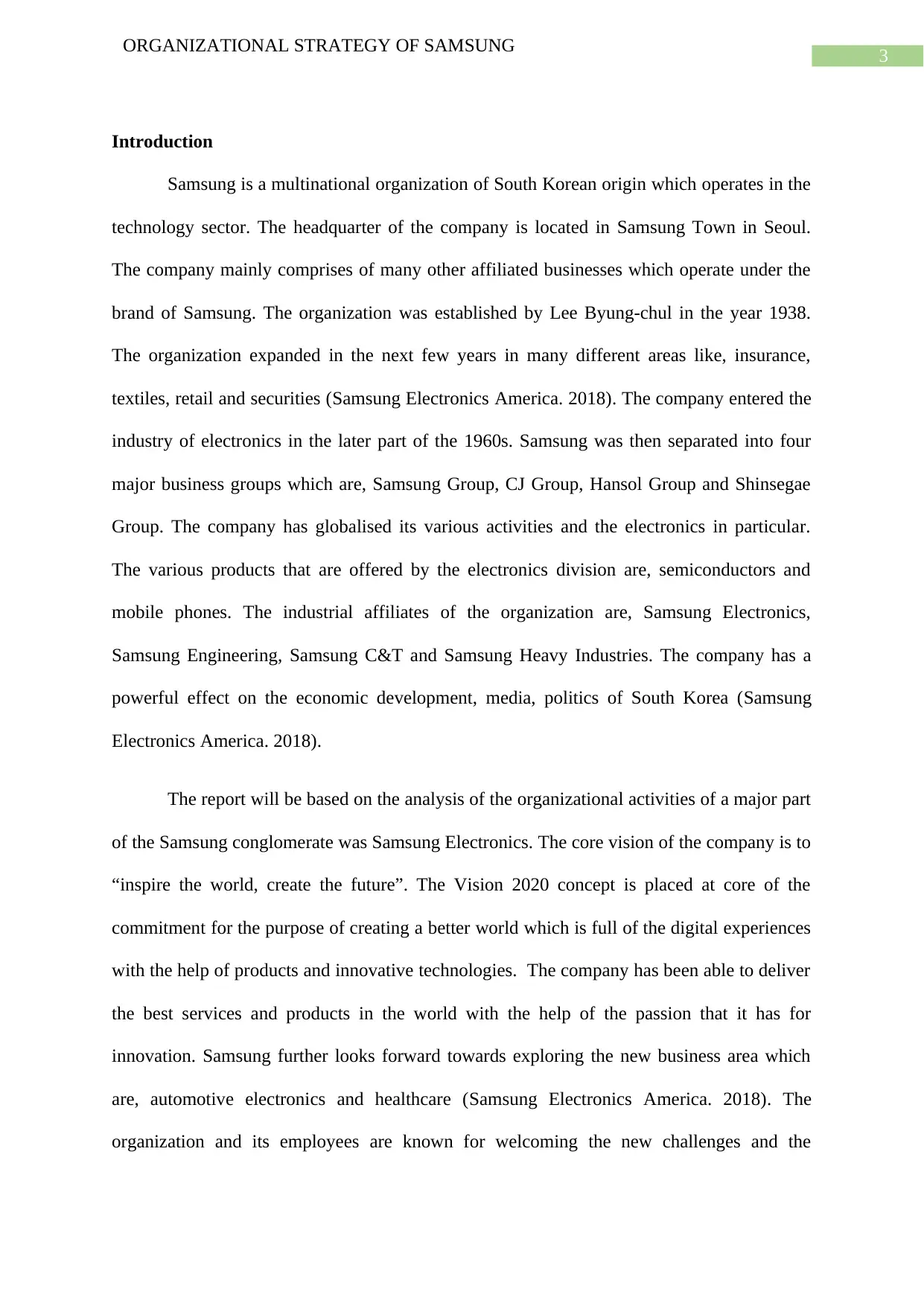
3
ORGANIZATIONAL STRATEGY OF SAMSUNG
Introduction
Samsung is a multinational organization of South Korean origin which operates in the
technology sector. The headquarter of the company is located in Samsung Town in Seoul.
The company mainly comprises of many other affiliated businesses which operate under the
brand of Samsung. The organization was established by Lee Byung-chul in the year 1938.
The organization expanded in the next few years in many different areas like, insurance,
textiles, retail and securities (Samsung Electronics America. 2018). The company entered the
industry of electronics in the later part of the 1960s. Samsung was then separated into four
major business groups which are, Samsung Group, CJ Group, Hansol Group and Shinsegae
Group. The company has globalised its various activities and the electronics in particular.
The various products that are offered by the electronics division are, semiconductors and
mobile phones. The industrial affiliates of the organization are, Samsung Electronics,
Samsung Engineering, Samsung C&T and Samsung Heavy Industries. The company has a
powerful effect on the economic development, media, politics of South Korea (Samsung
Electronics America. 2018).
The report will be based on the analysis of the organizational activities of a major part
of the Samsung conglomerate was Samsung Electronics. The core vision of the company is to
“inspire the world, create the future”. The Vision 2020 concept is placed at core of the
commitment for the purpose of creating a better world which is full of the digital experiences
with the help of products and innovative technologies. The company has been able to deliver
the best services and products in the world with the help of the passion that it has for
innovation. Samsung further looks forward towards exploring the new business area which
are, automotive electronics and healthcare (Samsung Electronics America. 2018). The
organization and its employees are known for welcoming the new challenges and the
ORGANIZATIONAL STRATEGY OF SAMSUNG
Introduction
Samsung is a multinational organization of South Korean origin which operates in the
technology sector. The headquarter of the company is located in Samsung Town in Seoul.
The company mainly comprises of many other affiliated businesses which operate under the
brand of Samsung. The organization was established by Lee Byung-chul in the year 1938.
The organization expanded in the next few years in many different areas like, insurance,
textiles, retail and securities (Samsung Electronics America. 2018). The company entered the
industry of electronics in the later part of the 1960s. Samsung was then separated into four
major business groups which are, Samsung Group, CJ Group, Hansol Group and Shinsegae
Group. The company has globalised its various activities and the electronics in particular.
The various products that are offered by the electronics division are, semiconductors and
mobile phones. The industrial affiliates of the organization are, Samsung Electronics,
Samsung Engineering, Samsung C&T and Samsung Heavy Industries. The company has a
powerful effect on the economic development, media, politics of South Korea (Samsung
Electronics America. 2018).
The report will be based on the analysis of the organizational activities of a major part
of the Samsung conglomerate was Samsung Electronics. The core vision of the company is to
“inspire the world, create the future”. The Vision 2020 concept is placed at core of the
commitment for the purpose of creating a better world which is full of the digital experiences
with the help of products and innovative technologies. The company has been able to deliver
the best services and products in the world with the help of the passion that it has for
innovation. Samsung further looks forward towards exploring the new business area which
are, automotive electronics and healthcare (Samsung Electronics America. 2018). The
organization and its employees are known for welcoming the new challenges and the
Paraphrase This Document
Need a fresh take? Get an instant paraphrase of this document with our AI Paraphraser
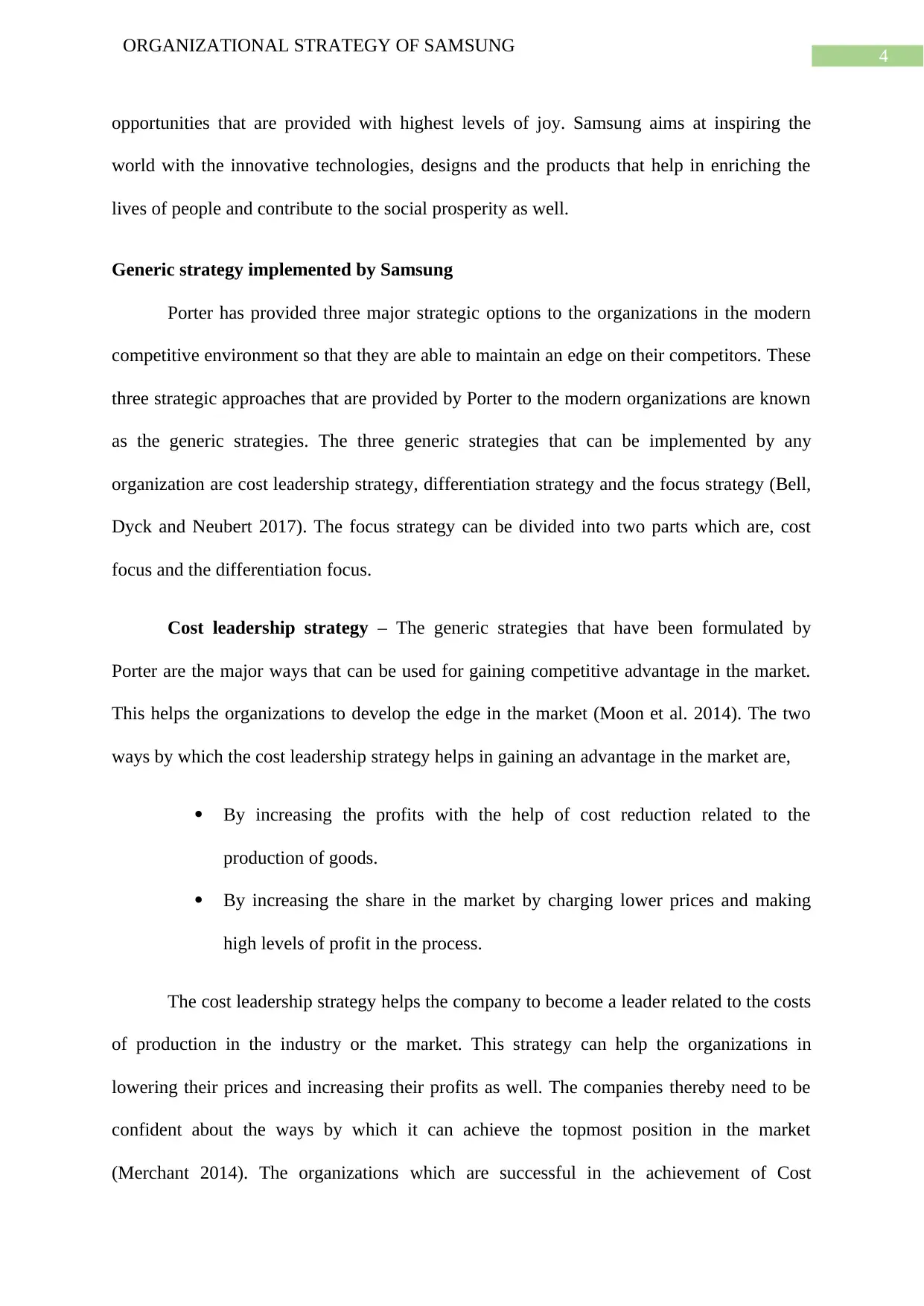
4
ORGANIZATIONAL STRATEGY OF SAMSUNG
opportunities that are provided with highest levels of joy. Samsung aims at inspiring the
world with the innovative technologies, designs and the products that help in enriching the
lives of people and contribute to the social prosperity as well.
Generic strategy implemented by Samsung
Porter has provided three major strategic options to the organizations in the modern
competitive environment so that they are able to maintain an edge on their competitors. These
three strategic approaches that are provided by Porter to the modern organizations are known
as the generic strategies. The three generic strategies that can be implemented by any
organization are cost leadership strategy, differentiation strategy and the focus strategy (Bell,
Dyck and Neubert 2017). The focus strategy can be divided into two parts which are, cost
focus and the differentiation focus.
Cost leadership strategy – The generic strategies that have been formulated by
Porter are the major ways that can be used for gaining competitive advantage in the market.
This helps the organizations to develop the edge in the market (Moon et al. 2014). The two
ways by which the cost leadership strategy helps in gaining an advantage in the market are,
By increasing the profits with the help of cost reduction related to the
production of goods.
By increasing the share in the market by charging lower prices and making
high levels of profit in the process.
The cost leadership strategy helps the company to become a leader related to the costs
of production in the industry or the market. This strategy can help the organizations in
lowering their prices and increasing their profits as well. The companies thereby need to be
confident about the ways by which it can achieve the topmost position in the market
(Merchant 2014). The organizations which are successful in the achievement of Cost
ORGANIZATIONAL STRATEGY OF SAMSUNG
opportunities that are provided with highest levels of joy. Samsung aims at inspiring the
world with the innovative technologies, designs and the products that help in enriching the
lives of people and contribute to the social prosperity as well.
Generic strategy implemented by Samsung
Porter has provided three major strategic options to the organizations in the modern
competitive environment so that they are able to maintain an edge on their competitors. These
three strategic approaches that are provided by Porter to the modern organizations are known
as the generic strategies. The three generic strategies that can be implemented by any
organization are cost leadership strategy, differentiation strategy and the focus strategy (Bell,
Dyck and Neubert 2017). The focus strategy can be divided into two parts which are, cost
focus and the differentiation focus.
Cost leadership strategy – The generic strategies that have been formulated by
Porter are the major ways that can be used for gaining competitive advantage in the market.
This helps the organizations to develop the edge in the market (Moon et al. 2014). The two
ways by which the cost leadership strategy helps in gaining an advantage in the market are,
By increasing the profits with the help of cost reduction related to the
production of goods.
By increasing the share in the market by charging lower prices and making
high levels of profit in the process.
The cost leadership strategy helps the company to become a leader related to the costs
of production in the industry or the market. This strategy can help the organizations in
lowering their prices and increasing their profits as well. The companies thereby need to be
confident about the ways by which it can achieve the topmost position in the market
(Merchant 2014). The organizations which are successful in the achievement of Cost
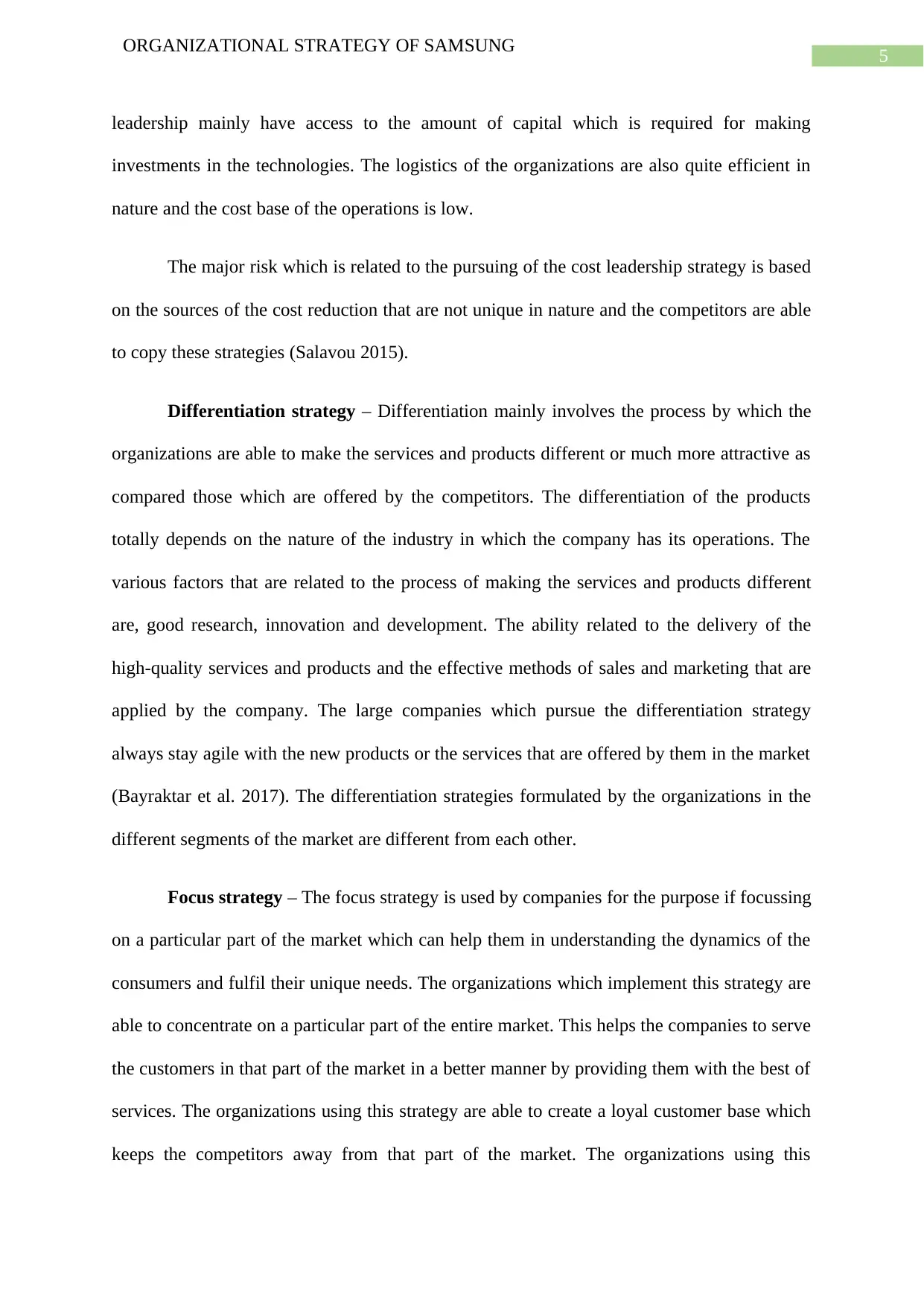
5
ORGANIZATIONAL STRATEGY OF SAMSUNG
leadership mainly have access to the amount of capital which is required for making
investments in the technologies. The logistics of the organizations are also quite efficient in
nature and the cost base of the operations is low.
The major risk which is related to the pursuing of the cost leadership strategy is based
on the sources of the cost reduction that are not unique in nature and the competitors are able
to copy these strategies (Salavou 2015).
Differentiation strategy – Differentiation mainly involves the process by which the
organizations are able to make the services and products different or much more attractive as
compared those which are offered by the competitors. The differentiation of the products
totally depends on the nature of the industry in which the company has its operations. The
various factors that are related to the process of making the services and products different
are, good research, innovation and development. The ability related to the delivery of the
high-quality services and products and the effective methods of sales and marketing that are
applied by the company. The large companies which pursue the differentiation strategy
always stay agile with the new products or the services that are offered by them in the market
(Bayraktar et al. 2017). The differentiation strategies formulated by the organizations in the
different segments of the market are different from each other.
Focus strategy – The focus strategy is used by companies for the purpose if focussing
on a particular part of the market which can help them in understanding the dynamics of the
consumers and fulfil their unique needs. The organizations which implement this strategy are
able to concentrate on a particular part of the entire market. This helps the companies to serve
the customers in that part of the market in a better manner by providing them with the best of
services. The organizations using this strategy are able to create a loyal customer base which
keeps the competitors away from that part of the market. The organizations using this
ORGANIZATIONAL STRATEGY OF SAMSUNG
leadership mainly have access to the amount of capital which is required for making
investments in the technologies. The logistics of the organizations are also quite efficient in
nature and the cost base of the operations is low.
The major risk which is related to the pursuing of the cost leadership strategy is based
on the sources of the cost reduction that are not unique in nature and the competitors are able
to copy these strategies (Salavou 2015).
Differentiation strategy – Differentiation mainly involves the process by which the
organizations are able to make the services and products different or much more attractive as
compared those which are offered by the competitors. The differentiation of the products
totally depends on the nature of the industry in which the company has its operations. The
various factors that are related to the process of making the services and products different
are, good research, innovation and development. The ability related to the delivery of the
high-quality services and products and the effective methods of sales and marketing that are
applied by the company. The large companies which pursue the differentiation strategy
always stay agile with the new products or the services that are offered by them in the market
(Bayraktar et al. 2017). The differentiation strategies formulated by the organizations in the
different segments of the market are different from each other.
Focus strategy – The focus strategy is used by companies for the purpose if focussing
on a particular part of the market which can help them in understanding the dynamics of the
consumers and fulfil their unique needs. The organizations which implement this strategy are
able to concentrate on a particular part of the entire market. This helps the companies to serve
the customers in that part of the market in a better manner by providing them with the best of
services. The organizations using this strategy are able to create a loyal customer base which
keeps the competitors away from that part of the market. The organizations using this
⊘ This is a preview!⊘
Do you want full access?
Subscribe today to unlock all pages.

Trusted by 1+ million students worldwide
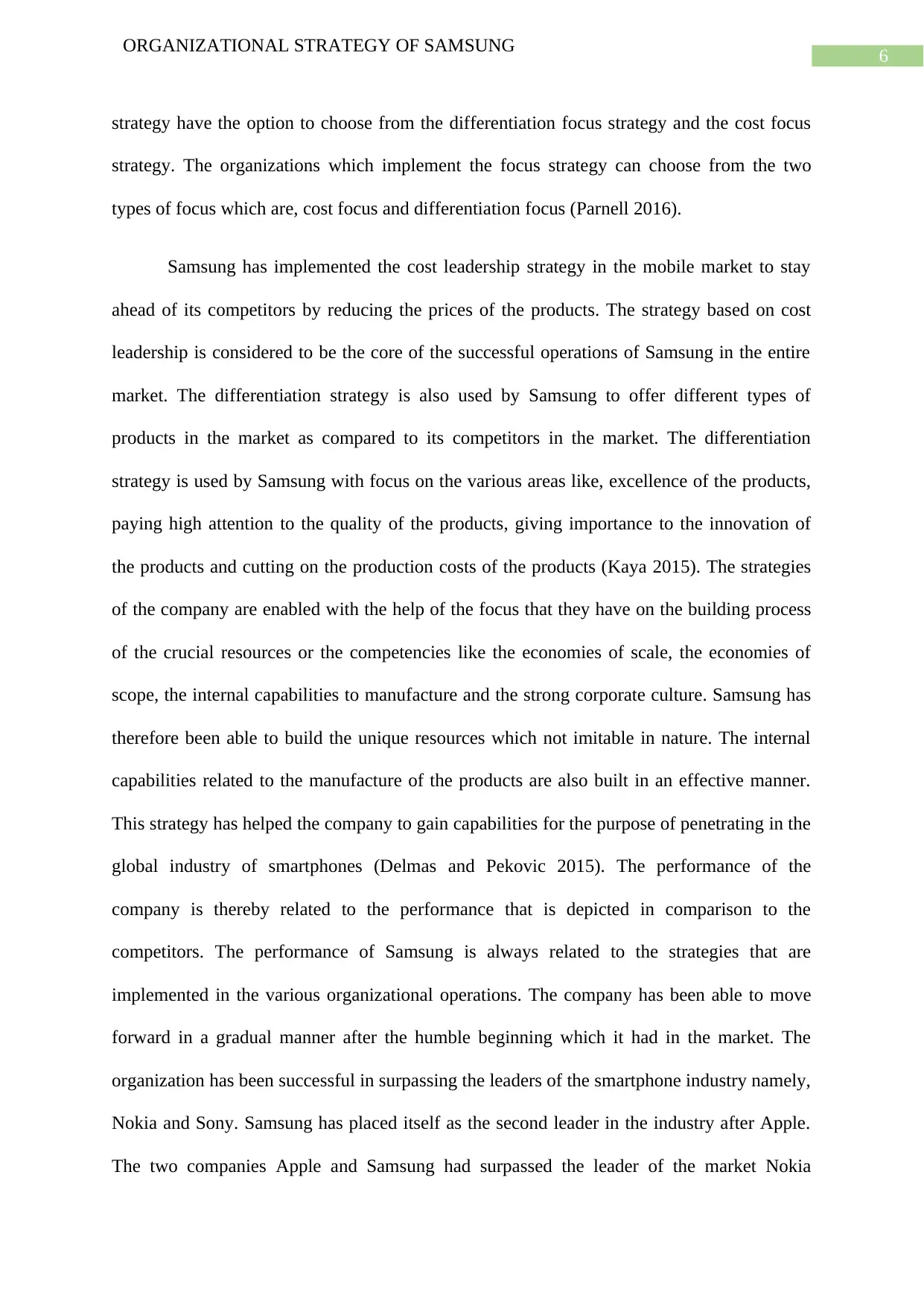
6
ORGANIZATIONAL STRATEGY OF SAMSUNG
strategy have the option to choose from the differentiation focus strategy and the cost focus
strategy. The organizations which implement the focus strategy can choose from the two
types of focus which are, cost focus and differentiation focus (Parnell 2016).
Samsung has implemented the cost leadership strategy in the mobile market to stay
ahead of its competitors by reducing the prices of the products. The strategy based on cost
leadership is considered to be the core of the successful operations of Samsung in the entire
market. The differentiation strategy is also used by Samsung to offer different types of
products in the market as compared to its competitors in the market. The differentiation
strategy is used by Samsung with focus on the various areas like, excellence of the products,
paying high attention to the quality of the products, giving importance to the innovation of
the products and cutting on the production costs of the products (Kaya 2015). The strategies
of the company are enabled with the help of the focus that they have on the building process
of the crucial resources or the competencies like the economies of scale, the economies of
scope, the internal capabilities to manufacture and the strong corporate culture. Samsung has
therefore been able to build the unique resources which not imitable in nature. The internal
capabilities related to the manufacture of the products are also built in an effective manner.
This strategy has helped the company to gain capabilities for the purpose of penetrating in the
global industry of smartphones (Delmas and Pekovic 2015). The performance of the
company is thereby related to the performance that is depicted in comparison to the
competitors. The performance of Samsung is always related to the strategies that are
implemented in the various organizational operations. The company has been able to move
forward in a gradual manner after the humble beginning which it had in the market. The
organization has been successful in surpassing the leaders of the smartphone industry namely,
Nokia and Sony. Samsung has placed itself as the second leader in the industry after Apple.
The two companies Apple and Samsung had surpassed the leader of the market Nokia
ORGANIZATIONAL STRATEGY OF SAMSUNG
strategy have the option to choose from the differentiation focus strategy and the cost focus
strategy. The organizations which implement the focus strategy can choose from the two
types of focus which are, cost focus and differentiation focus (Parnell 2016).
Samsung has implemented the cost leadership strategy in the mobile market to stay
ahead of its competitors by reducing the prices of the products. The strategy based on cost
leadership is considered to be the core of the successful operations of Samsung in the entire
market. The differentiation strategy is also used by Samsung to offer different types of
products in the market as compared to its competitors in the market. The differentiation
strategy is used by Samsung with focus on the various areas like, excellence of the products,
paying high attention to the quality of the products, giving importance to the innovation of
the products and cutting on the production costs of the products (Kaya 2015). The strategies
of the company are enabled with the help of the focus that they have on the building process
of the crucial resources or the competencies like the economies of scale, the economies of
scope, the internal capabilities to manufacture and the strong corporate culture. Samsung has
therefore been able to build the unique resources which not imitable in nature. The internal
capabilities related to the manufacture of the products are also built in an effective manner.
This strategy has helped the company to gain capabilities for the purpose of penetrating in the
global industry of smartphones (Delmas and Pekovic 2015). The performance of the
company is thereby related to the performance that is depicted in comparison to the
competitors. The performance of Samsung is always related to the strategies that are
implemented in the various organizational operations. The company has been able to move
forward in a gradual manner after the humble beginning which it had in the market. The
organization has been successful in surpassing the leaders of the smartphone industry namely,
Nokia and Sony. Samsung has placed itself as the second leader in the industry after Apple.
The two companies Apple and Samsung had surpassed the leader of the market Nokia
Paraphrase This Document
Need a fresh take? Get an instant paraphrase of this document with our AI Paraphraser
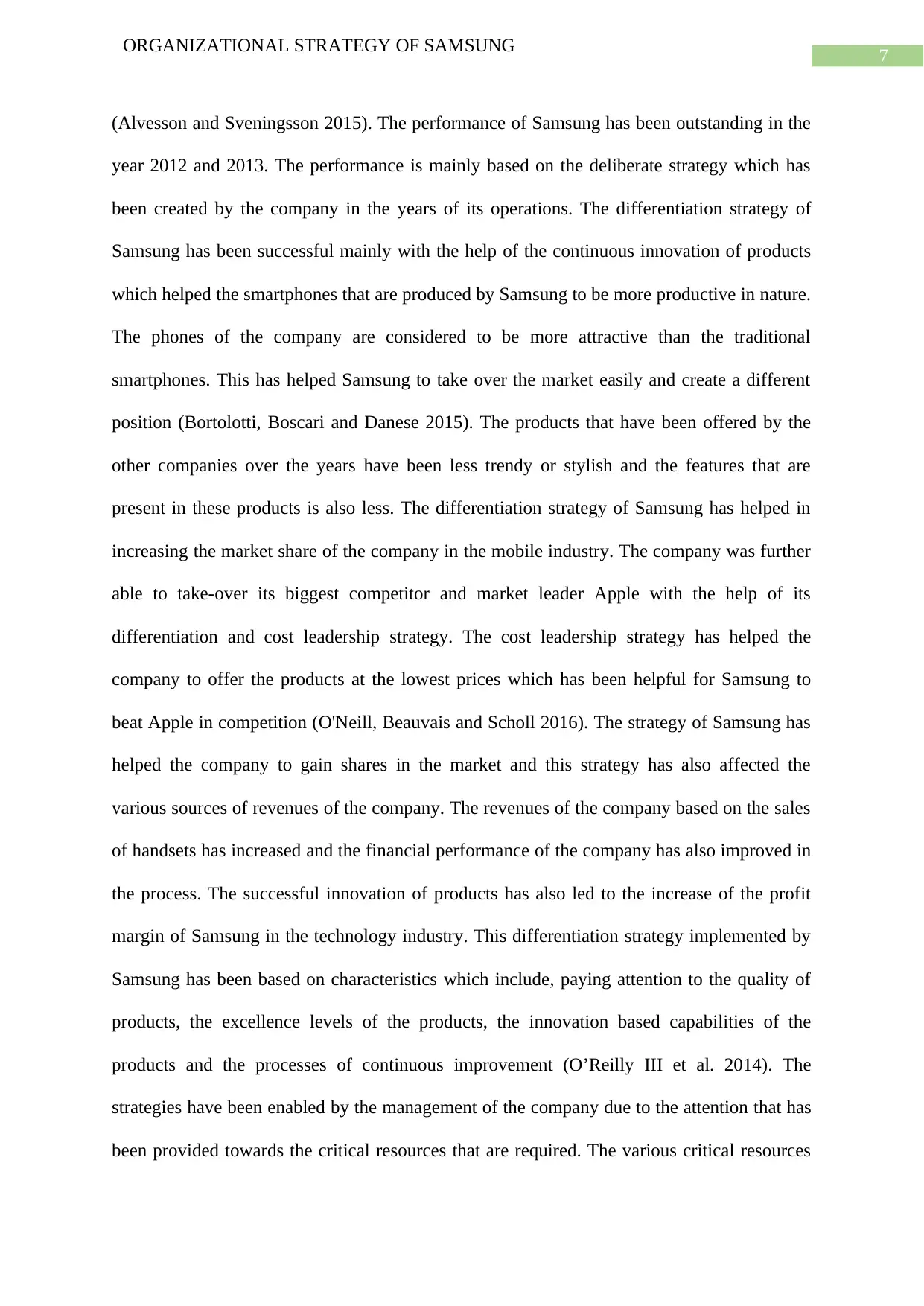
7
ORGANIZATIONAL STRATEGY OF SAMSUNG
(Alvesson and Sveningsson 2015). The performance of Samsung has been outstanding in the
year 2012 and 2013. The performance is mainly based on the deliberate strategy which has
been created by the company in the years of its operations. The differentiation strategy of
Samsung has been successful mainly with the help of the continuous innovation of products
which helped the smartphones that are produced by Samsung to be more productive in nature.
The phones of the company are considered to be more attractive than the traditional
smartphones. This has helped Samsung to take over the market easily and create a different
position (Bortolotti, Boscari and Danese 2015). The products that have been offered by the
other companies over the years have been less trendy or stylish and the features that are
present in these products is also less. The differentiation strategy of Samsung has helped in
increasing the market share of the company in the mobile industry. The company was further
able to take-over its biggest competitor and market leader Apple with the help of its
differentiation and cost leadership strategy. The cost leadership strategy has helped the
company to offer the products at the lowest prices which has been helpful for Samsung to
beat Apple in competition (O'Neill, Beauvais and Scholl 2016). The strategy of Samsung has
helped the company to gain shares in the market and this strategy has also affected the
various sources of revenues of the company. The revenues of the company based on the sales
of handsets has increased and the financial performance of the company has also improved in
the process. The successful innovation of products has also led to the increase of the profit
margin of Samsung in the technology industry. This differentiation strategy implemented by
Samsung has been based on characteristics which include, paying attention to the quality of
products, the excellence levels of the products, the innovation based capabilities of the
products and the processes of continuous improvement (O’Reilly III et al. 2014). The
strategies have been enabled by the management of the company due to the attention that has
been provided towards the critical resources that are required. The various critical resources
ORGANIZATIONAL STRATEGY OF SAMSUNG
(Alvesson and Sveningsson 2015). The performance of Samsung has been outstanding in the
year 2012 and 2013. The performance is mainly based on the deliberate strategy which has
been created by the company in the years of its operations. The differentiation strategy of
Samsung has been successful mainly with the help of the continuous innovation of products
which helped the smartphones that are produced by Samsung to be more productive in nature.
The phones of the company are considered to be more attractive than the traditional
smartphones. This has helped Samsung to take over the market easily and create a different
position (Bortolotti, Boscari and Danese 2015). The products that have been offered by the
other companies over the years have been less trendy or stylish and the features that are
present in these products is also less. The differentiation strategy of Samsung has helped in
increasing the market share of the company in the mobile industry. The company was further
able to take-over its biggest competitor and market leader Apple with the help of its
differentiation and cost leadership strategy. The cost leadership strategy has helped the
company to offer the products at the lowest prices which has been helpful for Samsung to
beat Apple in competition (O'Neill, Beauvais and Scholl 2016). The strategy of Samsung has
helped the company to gain shares in the market and this strategy has also affected the
various sources of revenues of the company. The revenues of the company based on the sales
of handsets has increased and the financial performance of the company has also improved in
the process. The successful innovation of products has also led to the increase of the profit
margin of Samsung in the technology industry. This differentiation strategy implemented by
Samsung has been based on characteristics which include, paying attention to the quality of
products, the excellence levels of the products, the innovation based capabilities of the
products and the processes of continuous improvement (O’Reilly III et al. 2014). The
strategies have been enabled by the management of the company due to the attention that has
been provided towards the critical resources that are required. The various critical resources
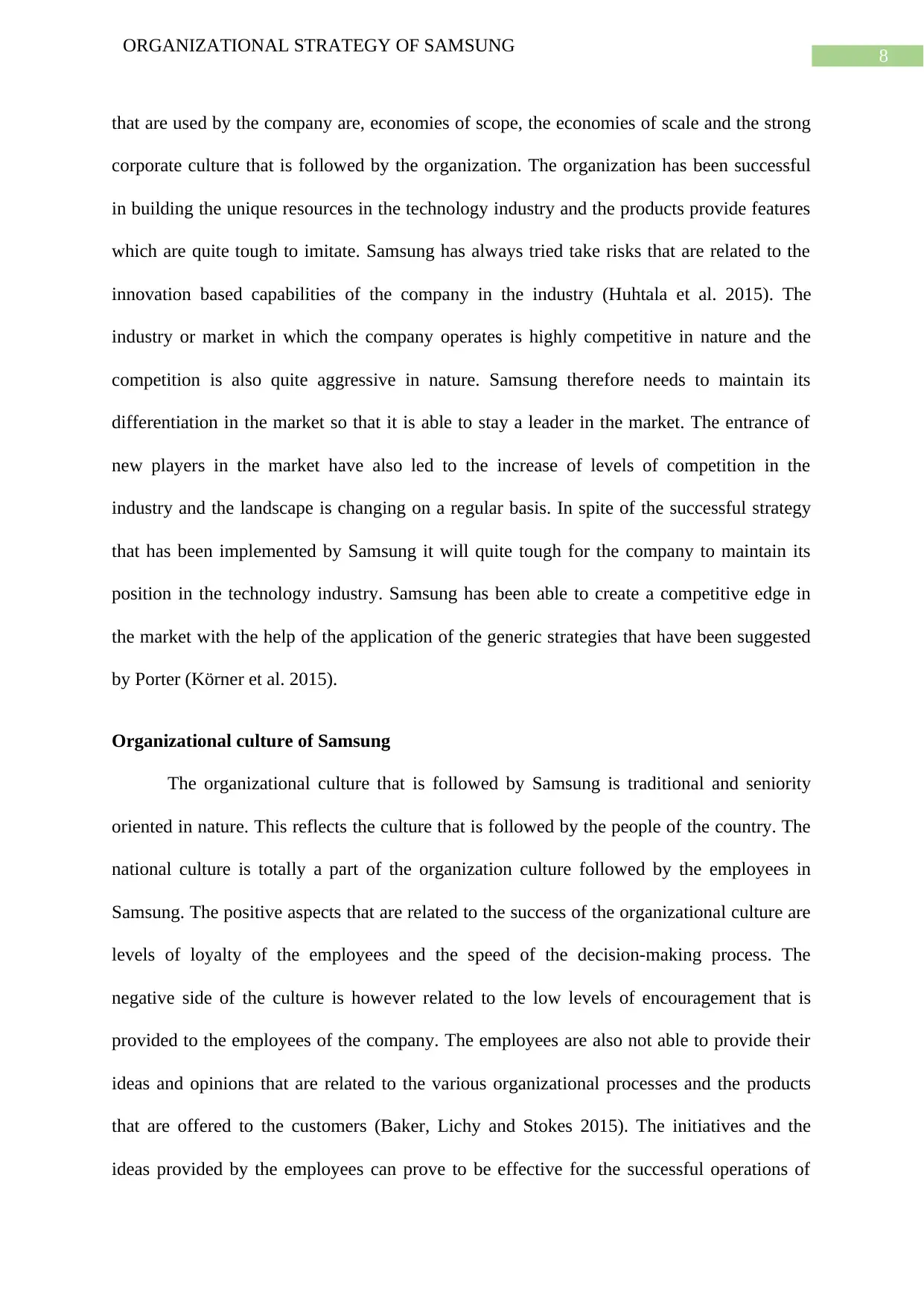
8
ORGANIZATIONAL STRATEGY OF SAMSUNG
that are used by the company are, economies of scope, the economies of scale and the strong
corporate culture that is followed by the organization. The organization has been successful
in building the unique resources in the technology industry and the products provide features
which are quite tough to imitate. Samsung has always tried take risks that are related to the
innovation based capabilities of the company in the industry (Huhtala et al. 2015). The
industry or market in which the company operates is highly competitive in nature and the
competition is also quite aggressive in nature. Samsung therefore needs to maintain its
differentiation in the market so that it is able to stay a leader in the market. The entrance of
new players in the market have also led to the increase of levels of competition in the
industry and the landscape is changing on a regular basis. In spite of the successful strategy
that has been implemented by Samsung it will quite tough for the company to maintain its
position in the technology industry. Samsung has been able to create a competitive edge in
the market with the help of the application of the generic strategies that have been suggested
by Porter (Körner et al. 2015).
Organizational culture of Samsung
The organizational culture that is followed by Samsung is traditional and seniority
oriented in nature. This reflects the culture that is followed by the people of the country. The
national culture is totally a part of the organization culture followed by the employees in
Samsung. The positive aspects that are related to the success of the organizational culture are
levels of loyalty of the employees and the speed of the decision-making process. The
negative side of the culture is however related to the low levels of encouragement that is
provided to the employees of the company. The employees are also not able to provide their
ideas and opinions that are related to the various organizational processes and the products
that are offered to the customers (Baker, Lichy and Stokes 2015). The initiatives and the
ideas provided by the employees can prove to be effective for the successful operations of
ORGANIZATIONAL STRATEGY OF SAMSUNG
that are used by the company are, economies of scope, the economies of scale and the strong
corporate culture that is followed by the organization. The organization has been successful
in building the unique resources in the technology industry and the products provide features
which are quite tough to imitate. Samsung has always tried take risks that are related to the
innovation based capabilities of the company in the industry (Huhtala et al. 2015). The
industry or market in which the company operates is highly competitive in nature and the
competition is also quite aggressive in nature. Samsung therefore needs to maintain its
differentiation in the market so that it is able to stay a leader in the market. The entrance of
new players in the market have also led to the increase of levels of competition in the
industry and the landscape is changing on a regular basis. In spite of the successful strategy
that has been implemented by Samsung it will quite tough for the company to maintain its
position in the technology industry. Samsung has been able to create a competitive edge in
the market with the help of the application of the generic strategies that have been suggested
by Porter (Körner et al. 2015).
Organizational culture of Samsung
The organizational culture that is followed by Samsung is traditional and seniority
oriented in nature. This reflects the culture that is followed by the people of the country. The
national culture is totally a part of the organization culture followed by the employees in
Samsung. The positive aspects that are related to the success of the organizational culture are
levels of loyalty of the employees and the speed of the decision-making process. The
negative side of the culture is however related to the low levels of encouragement that is
provided to the employees of the company. The employees are also not able to provide their
ideas and opinions that are related to the various organizational processes and the products
that are offered to the customers (Baker, Lichy and Stokes 2015). The initiatives and the
ideas provided by the employees can prove to be effective for the successful operations of
⊘ This is a preview!⊘
Do you want full access?
Subscribe today to unlock all pages.

Trusted by 1+ million students worldwide
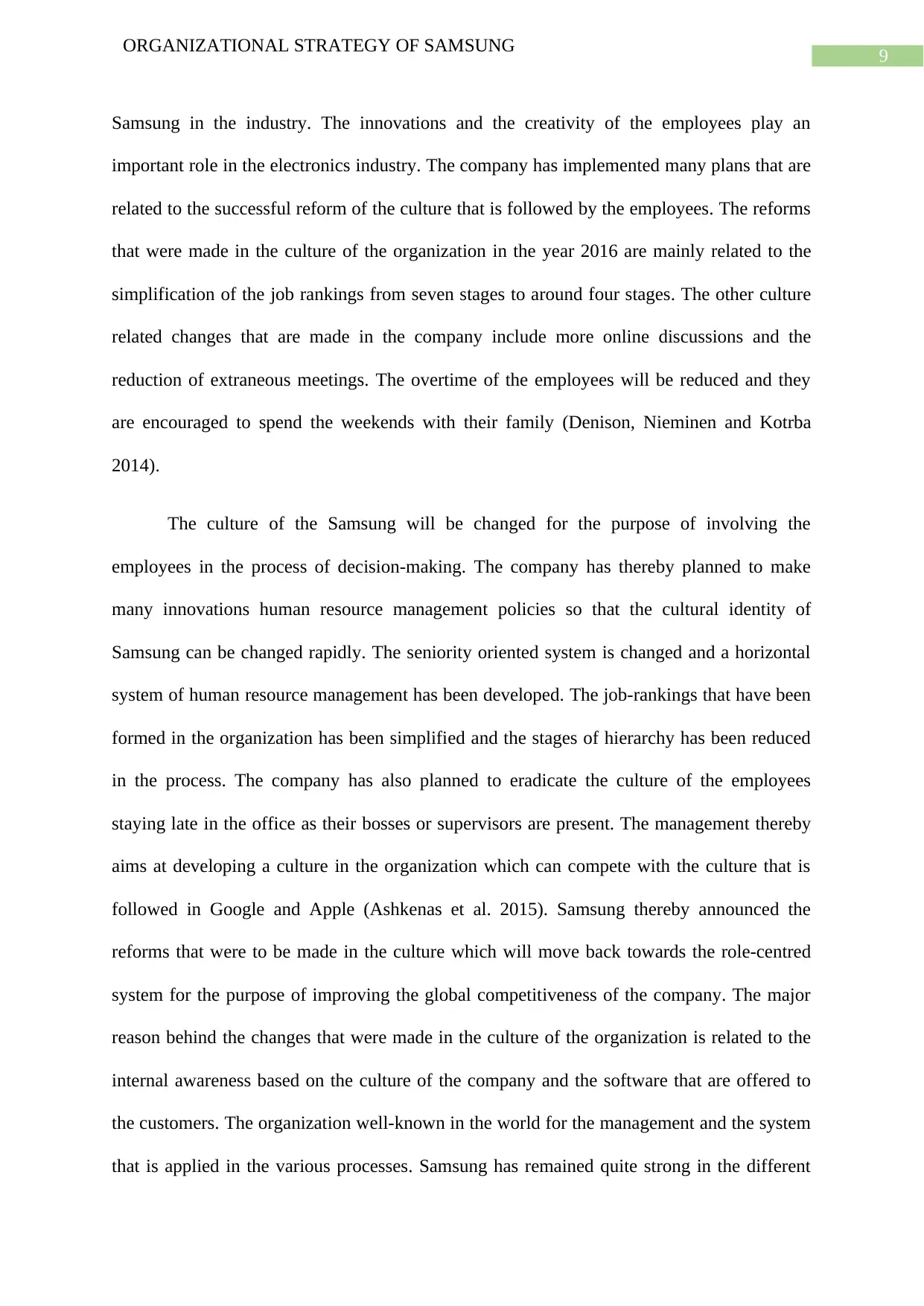
9
ORGANIZATIONAL STRATEGY OF SAMSUNG
Samsung in the industry. The innovations and the creativity of the employees play an
important role in the electronics industry. The company has implemented many plans that are
related to the successful reform of the culture that is followed by the employees. The reforms
that were made in the culture of the organization in the year 2016 are mainly related to the
simplification of the job rankings from seven stages to around four stages. The other culture
related changes that are made in the company include more online discussions and the
reduction of extraneous meetings. The overtime of the employees will be reduced and they
are encouraged to spend the weekends with their family (Denison, Nieminen and Kotrba
2014).
The culture of the Samsung will be changed for the purpose of involving the
employees in the process of decision-making. The company has thereby planned to make
many innovations human resource management policies so that the cultural identity of
Samsung can be changed rapidly. The seniority oriented system is changed and a horizontal
system of human resource management has been developed. The job-rankings that have been
formed in the organization has been simplified and the stages of hierarchy has been reduced
in the process. The company has also planned to eradicate the culture of the employees
staying late in the office as their bosses or supervisors are present. The management thereby
aims at developing a culture in the organization which can compete with the culture that is
followed in Google and Apple (Ashkenas et al. 2015). Samsung thereby announced the
reforms that were to be made in the culture which will move back towards the role-centred
system for the purpose of improving the global competitiveness of the company. The major
reason behind the changes that were made in the culture of the organization is related to the
internal awareness based on the culture of the company and the software that are offered to
the customers. The organization well-known in the world for the management and the system
that is applied in the various processes. Samsung has remained quite strong in the different
ORGANIZATIONAL STRATEGY OF SAMSUNG
Samsung in the industry. The innovations and the creativity of the employees play an
important role in the electronics industry. The company has implemented many plans that are
related to the successful reform of the culture that is followed by the employees. The reforms
that were made in the culture of the organization in the year 2016 are mainly related to the
simplification of the job rankings from seven stages to around four stages. The other culture
related changes that are made in the company include more online discussions and the
reduction of extraneous meetings. The overtime of the employees will be reduced and they
are encouraged to spend the weekends with their family (Denison, Nieminen and Kotrba
2014).
The culture of the Samsung will be changed for the purpose of involving the
employees in the process of decision-making. The company has thereby planned to make
many innovations human resource management policies so that the cultural identity of
Samsung can be changed rapidly. The seniority oriented system is changed and a horizontal
system of human resource management has been developed. The job-rankings that have been
formed in the organization has been simplified and the stages of hierarchy has been reduced
in the process. The company has also planned to eradicate the culture of the employees
staying late in the office as their bosses or supervisors are present. The management thereby
aims at developing a culture in the organization which can compete with the culture that is
followed in Google and Apple (Ashkenas et al. 2015). Samsung thereby announced the
reforms that were to be made in the culture which will move back towards the role-centred
system for the purpose of improving the global competitiveness of the company. The major
reason behind the changes that were made in the culture of the organization is related to the
internal awareness based on the culture of the company and the software that are offered to
the customers. The organization well-known in the world for the management and the system
that is applied in the various processes. Samsung has remained quite strong in the different
Paraphrase This Document
Need a fresh take? Get an instant paraphrase of this document with our AI Paraphraser
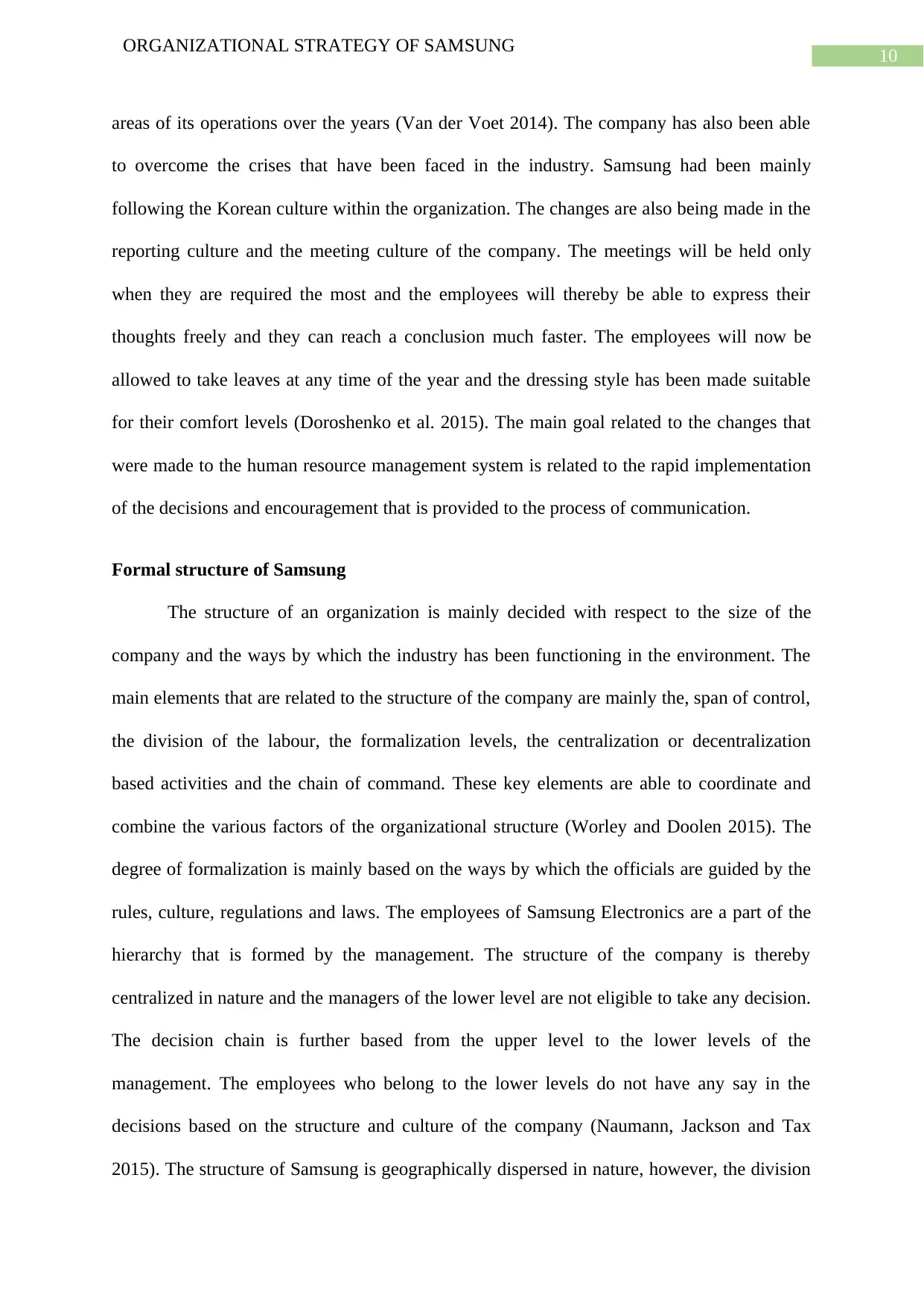
10
ORGANIZATIONAL STRATEGY OF SAMSUNG
areas of its operations over the years (Van der Voet 2014). The company has also been able
to overcome the crises that have been faced in the industry. Samsung had been mainly
following the Korean culture within the organization. The changes are also being made in the
reporting culture and the meeting culture of the company. The meetings will be held only
when they are required the most and the employees will thereby be able to express their
thoughts freely and they can reach a conclusion much faster. The employees will now be
allowed to take leaves at any time of the year and the dressing style has been made suitable
for their comfort levels (Doroshenko et al. 2015). The main goal related to the changes that
were made to the human resource management system is related to the rapid implementation
of the decisions and encouragement that is provided to the process of communication.
Formal structure of Samsung
The structure of an organization is mainly decided with respect to the size of the
company and the ways by which the industry has been functioning in the environment. The
main elements that are related to the structure of the company are mainly the, span of control,
the division of the labour, the formalization levels, the centralization or decentralization
based activities and the chain of command. These key elements are able to coordinate and
combine the various factors of the organizational structure (Worley and Doolen 2015). The
degree of formalization is mainly based on the ways by which the officials are guided by the
rules, culture, regulations and laws. The employees of Samsung Electronics are a part of the
hierarchy that is formed by the management. The structure of the company is thereby
centralized in nature and the managers of the lower level are not eligible to take any decision.
The decision chain is further based from the upper level to the lower levels of the
management. The employees who belong to the lower levels do not have any say in the
decisions based on the structure and culture of the company (Naumann, Jackson and Tax
2015). The structure of Samsung is geographically dispersed in nature, however, the division
ORGANIZATIONAL STRATEGY OF SAMSUNG
areas of its operations over the years (Van der Voet 2014). The company has also been able
to overcome the crises that have been faced in the industry. Samsung had been mainly
following the Korean culture within the organization. The changes are also being made in the
reporting culture and the meeting culture of the company. The meetings will be held only
when they are required the most and the employees will thereby be able to express their
thoughts freely and they can reach a conclusion much faster. The employees will now be
allowed to take leaves at any time of the year and the dressing style has been made suitable
for their comfort levels (Doroshenko et al. 2015). The main goal related to the changes that
were made to the human resource management system is related to the rapid implementation
of the decisions and encouragement that is provided to the process of communication.
Formal structure of Samsung
The structure of an organization is mainly decided with respect to the size of the
company and the ways by which the industry has been functioning in the environment. The
main elements that are related to the structure of the company are mainly the, span of control,
the division of the labour, the formalization levels, the centralization or decentralization
based activities and the chain of command. These key elements are able to coordinate and
combine the various factors of the organizational structure (Worley and Doolen 2015). The
degree of formalization is mainly based on the ways by which the officials are guided by the
rules, culture, regulations and laws. The employees of Samsung Electronics are a part of the
hierarchy that is formed by the management. The structure of the company is thereby
centralized in nature and the managers of the lower level are not eligible to take any decision.
The decision chain is further based from the upper level to the lower levels of the
management. The employees who belong to the lower levels do not have any say in the
decisions based on the structure and culture of the company (Naumann, Jackson and Tax
2015). The structure of Samsung is geographically dispersed in nature, however, the division
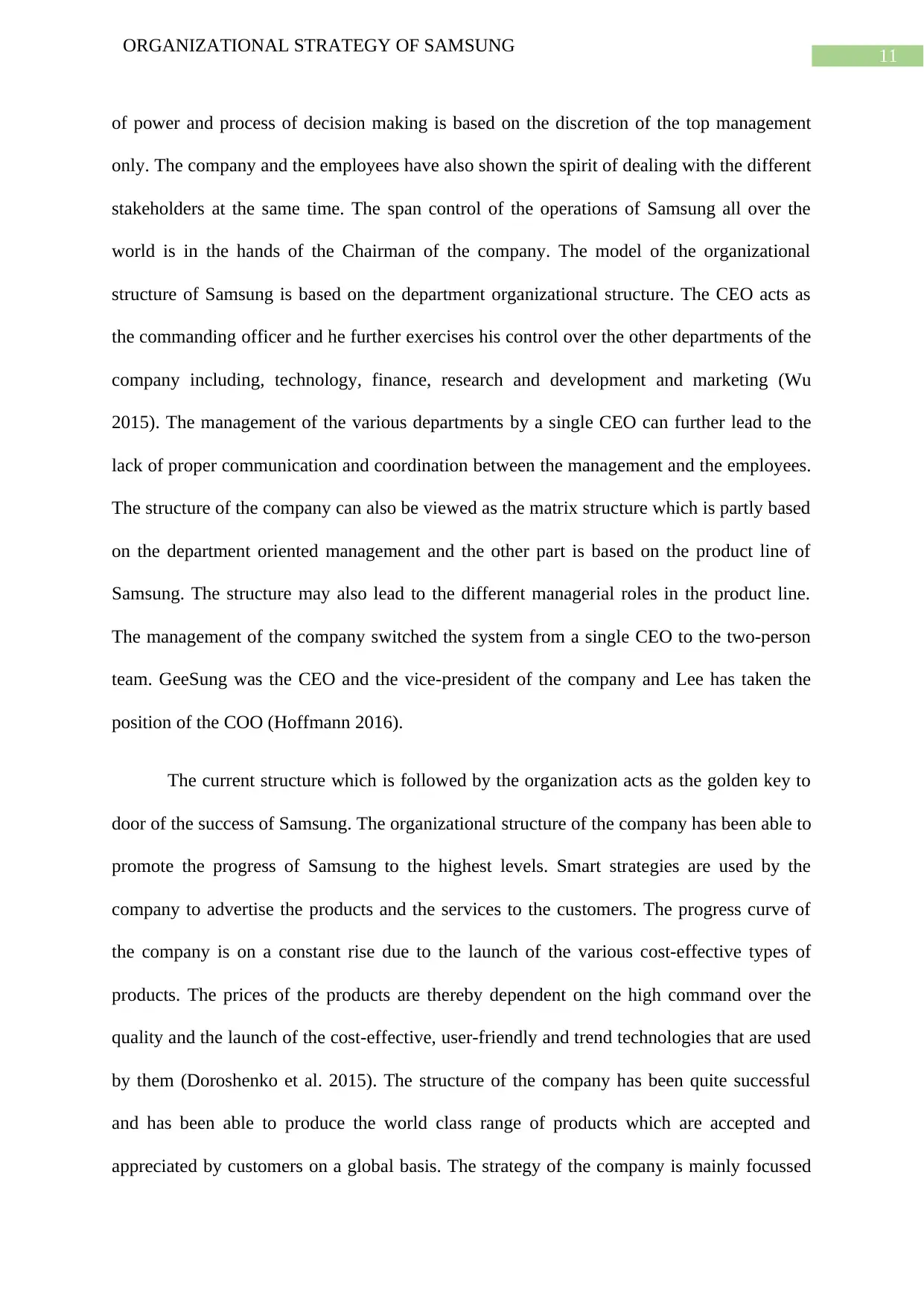
11
ORGANIZATIONAL STRATEGY OF SAMSUNG
of power and process of decision making is based on the discretion of the top management
only. The company and the employees have also shown the spirit of dealing with the different
stakeholders at the same time. The span control of the operations of Samsung all over the
world is in the hands of the Chairman of the company. The model of the organizational
structure of Samsung is based on the department organizational structure. The CEO acts as
the commanding officer and he further exercises his control over the other departments of the
company including, technology, finance, research and development and marketing (Wu
2015). The management of the various departments by a single CEO can further lead to the
lack of proper communication and coordination between the management and the employees.
The structure of the company can also be viewed as the matrix structure which is partly based
on the department oriented management and the other part is based on the product line of
Samsung. The structure may also lead to the different managerial roles in the product line.
The management of the company switched the system from a single CEO to the two-person
team. GeeSung was the CEO and the vice-president of the company and Lee has taken the
position of the COO (Hoffmann 2016).
The current structure which is followed by the organization acts as the golden key to
door of the success of Samsung. The organizational structure of the company has been able to
promote the progress of Samsung to the highest levels. Smart strategies are used by the
company to advertise the products and the services to the customers. The progress curve of
the company is on a constant rise due to the launch of the various cost-effective types of
products. The prices of the products are thereby dependent on the high command over the
quality and the launch of the cost-effective, user-friendly and trend technologies that are used
by them (Doroshenko et al. 2015). The structure of the company has been quite successful
and has been able to produce the world class range of products which are accepted and
appreciated by customers on a global basis. The strategy of the company is mainly focussed
ORGANIZATIONAL STRATEGY OF SAMSUNG
of power and process of decision making is based on the discretion of the top management
only. The company and the employees have also shown the spirit of dealing with the different
stakeholders at the same time. The span control of the operations of Samsung all over the
world is in the hands of the Chairman of the company. The model of the organizational
structure of Samsung is based on the department organizational structure. The CEO acts as
the commanding officer and he further exercises his control over the other departments of the
company including, technology, finance, research and development and marketing (Wu
2015). The management of the various departments by a single CEO can further lead to the
lack of proper communication and coordination between the management and the employees.
The structure of the company can also be viewed as the matrix structure which is partly based
on the department oriented management and the other part is based on the product line of
Samsung. The structure may also lead to the different managerial roles in the product line.
The management of the company switched the system from a single CEO to the two-person
team. GeeSung was the CEO and the vice-president of the company and Lee has taken the
position of the COO (Hoffmann 2016).
The current structure which is followed by the organization acts as the golden key to
door of the success of Samsung. The organizational structure of the company has been able to
promote the progress of Samsung to the highest levels. Smart strategies are used by the
company to advertise the products and the services to the customers. The progress curve of
the company is on a constant rise due to the launch of the various cost-effective types of
products. The prices of the products are thereby dependent on the high command over the
quality and the launch of the cost-effective, user-friendly and trend technologies that are used
by them (Doroshenko et al. 2015). The structure of the company has been quite successful
and has been able to produce the world class range of products which are accepted and
appreciated by customers on a global basis. The strategy of the company is mainly focussed
⊘ This is a preview!⊘
Do you want full access?
Subscribe today to unlock all pages.

Trusted by 1+ million students worldwide
1 out of 17
Related Documents
Your All-in-One AI-Powered Toolkit for Academic Success.
+13062052269
info@desklib.com
Available 24*7 on WhatsApp / Email
![[object Object]](/_next/static/media/star-bottom.7253800d.svg)
Unlock your academic potential
Copyright © 2020–2025 A2Z Services. All Rights Reserved. Developed and managed by ZUCOL.





